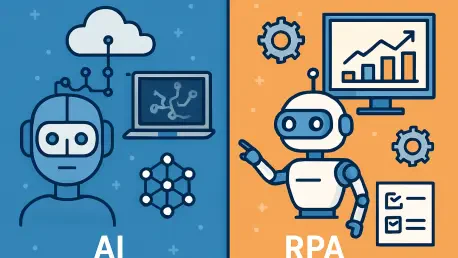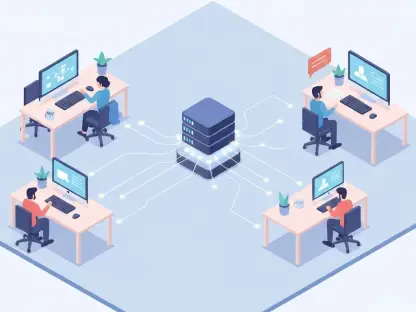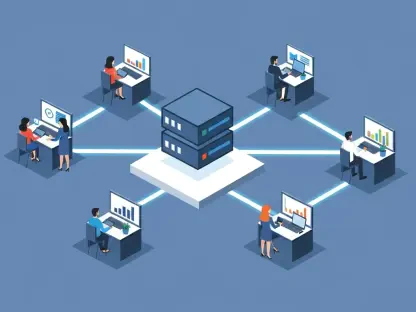In the rapidly evolving landscape of modern business, the pressure to optimize operations and maintain a competitive edge has never been greater, making automation a critical strategy for success. Companies across industries are turning to cutting-edge technologies to streamline workflows, reduce human error, and free up valuable time for strategic initiatives. Among the most prominent tools driving this transformation are Artificial Intelligence (AI) Agents and Robotic Process Automation (RPA), each offering unique approaches to tackling repetitive and complex tasks. While both promise to revolutionize efficiency, their differing capabilities mean that choosing the right one—or a blend of both—requires a deep understanding of specific business needs. This exploration aims to unpack the distinctions between these powerful automation solutions, providing clarity on how they function, where they excel, and what considerations should guide decision-making. By delving into practical applications and emerging trends, the goal is to equip business leaders with actionable insights to harness automation effectively.
Understanding the Basics of Automation Tools
What is RPA?
Robotic Process Automation, commonly known as RPA, stands as a foundational software-based solution engineered to handle repetitive, rule-based tasks with precision. It operates by mimicking human actions within digital systems, following strict instructions to process structured data without deviation. This technology is particularly valued for its ability to automate mundane activities like data entry, invoice processing, and payroll management, which often consume significant time and resources. The appeal of RPA lies in its predictability and cost-effectiveness, offering businesses a straightforward way to enhance efficiency in environments where processes remain consistent. For industries dealing with high volumes of routine transactions, such as finance or logistics, RPA acts as a reliable digital worker, executing tasks with speed and accuracy that far surpass manual efforts, thus reducing operational bottlenecks.
Beyond its core functionality, RPA’s strength is rooted in its simplicity of deployment and minimal need for ongoing adjustments once configured. It thrives in scenarios where data is neatly organized—think spreadsheets or standardized forms—and where the rules governing a process are unlikely to change. This makes it an ideal choice for tasks such as updating customer records or generating routine reports based on predefined templates. However, its rigid nature means it cannot adapt to unexpected variables or interpret information outside its programmed parameters. Businesses seeking to implement RPA should carefully map out their workflows to ensure compatibility, as this tool delivers maximum value when applied to stable, structured environments. Its affordability also positions it as an entry point for companies new to automation, providing immediate returns without the complexity of more advanced systems.
What are AI Agents?
AI Agents represent a leap forward in automation, leveraging sophisticated technologies like machine learning, natural language processing, and computer vision to address intricate, dynamic challenges. Unlike tools bound by fixed rules, these systems are designed to interact with unstructured data—such as human language, images, or video content—and make autonomous decisions based on patterns and insights. Their capacity to analyze customer sentiment from emails, prioritize urgent communications, or draft personalized responses showcases a level of intelligence that mimics human cognition. This adaptability makes AI Agents invaluable in sectors where interactions are nuanced, such as customer service or marketing, allowing for tailored solutions that evolve with changing conditions and user needs.
The true power of AI Agents lies in their ability to learn over time, refining their approach as they encounter new data or scenarios. For instance, in a call center environment, an AI Agent can not only transcribe conversations but also gauge emotional tone, suggest responses, and even predict customer needs based on historical interactions. This continuous improvement sets them apart from static automation tools, though it comes with higher implementation costs and complexity. Businesses must weigh these factors against the potential for long-term gains, especially in roles requiring flexibility and decision-making. As a transformative force, AI Agents push the boundaries of what automation can achieve, offering a glimpse into a future where technology anticipates and resolves issues before they fully emerge.
Key Differences in Capabilities and Use Cases
RPPrecision for Routine Tasks
Robotic Process Automation excels in environments where tasks are repetitive, predictable, and grounded in structured data, delivering unmatched precision without the need for adaptation. Its core function is to execute predefined instructions, making it a perfect fit for processes like transferring data between systems, categorizing customer information based on set criteria, or automating routine compliance checks. In industries such as banking, RPA can handle transaction logging or account updates with flawless consistency, ensuring accuracy while minimizing human intervention. This reliability is a cornerstone for businesses aiming to scale operations without proportional increases in labor costs, providing a foundation for efficiency in well-defined workflows.
However, the limitations of RPA become apparent when tasks deviate from established patterns or require interpretation beyond its coded rules. It lacks the ability to handle exceptions or make judgment calls, meaning any variation in process or data format can disrupt its performance. For example, if a dataset includes unexpected errors or unstructured entries, RPA will falter without manual oversight to correct the course. This underscores the importance of applying RPA only to stable, repetitive functions where consistency is guaranteed. Businesses can maximize its value by pairing it with thorough process documentation, ensuring that the tool operates within its optimal scope while delivering measurable time and cost savings.
AI Agents: Intelligence for Dynamic Challenges
AI Agents bring a distinct advantage to automation by tackling tasks that demand interpretation, adaptability, and a deeper understanding of context, far surpassing the capabilities of rule-based systems. These agents can process unstructured data—like customer feedback in text or voice format—and extract meaningful insights, such as emotional tone or intent, to inform their actions. In customer service, for instance, an AI Agent might manage a flood of emails by not only sorting them by priority but also crafting tailored replies that reflect the sender’s mood or urgency. This level of sophistication enables businesses to maintain a personal touch at scale, enhancing user satisfaction in ways static tools cannot match.
Moreover, the learning capacity of AI Agents allows them to evolve with each interaction, continuously improving their responses and decision-making processes. In a sales context, they might analyze past customer behavior to predict future needs, offering personalized recommendations that drive engagement. This dynamic nature makes them suited for environments where change is constant, though it requires robust data infrastructure and expertise to manage effectively. The investment in AI Agents often pays off in scenarios where human-like interaction or complex problem-solving is essential, positioning them as a strategic asset for forward-thinking organizations aiming to stay ahead of evolving market demands.
Choosing the Right Tool for Your Business
Assessing Task Requirements
Selecting the appropriate automation tool begins with a thorough evaluation of the specific tasks at hand, focusing on their complexity, data structure, and variability to determine whether simplicity or adaptability is needed. For repetitive actions with clear targets and structured inputs—such as processing standard forms or updating databases—RPA offers a streamlined, efficient solution that minimizes setup time and cost. Conversely, tasks involving human interaction, nuanced interpretation, or evolving datasets—like managing social media engagement or triaging customer inquiries—call for the advanced capabilities of AI Agents. Business leaders should map out the nature of their workflows, asking pointed questions about whether the process demands strict adherence to rules or the flexibility to handle ambiguity, ensuring alignment with operational goals.
Beyond initial assessments, it’s critical to consider the scalability and long-term implications of the chosen tool in relation to business growth and changing needs. RPA might suffice for current routine demands, but if future expansion introduces more dynamic challenges, an over-reliance on it could lead to inefficiencies. AI Agents, while resource-intensive upfront, provide a buffer against such shifts by adapting to new patterns over time. A practical approach involves testing automation on a small scale, observing outcomes, and adjusting strategies accordingly. By prioritizing a clear understanding of task requirements and anticipating potential shifts, companies can avoid costly missteps and build a foundation for sustainable automation that supports both immediate and future objectives.
Exploring Hybrid Solutions
An emerging trend in automation is the integration of RPA and AI Agents, creating hybrid solutions that combine the strengths of both to address multifaceted business challenges with greater impact. This approach leverages RPA’s precision for handling routine, structured components of a process while employing AI Agents to manage aspects requiring intelligence and adaptability. In HR onboarding, for example, RPA can automate form processing, access setup, and compliance checks, ensuring consistency in administrative tasks. Simultaneously, an AI Agent can offer personalized guidance to new hires, answer unique queries, and monitor system interactions for potential issues, enhancing the overall experience. This synergy allows businesses to cover a broader spectrum of needs within a single workflow.
The adoption of hybrid models also reflects a pragmatic response to the limitations inherent in standalone tools, offering a balanced strategy that maximizes efficiency and innovation. By integrating RPA’s cost-effective reliability with AI’s capacity for nuanced decision-making, companies can tackle complex projects without sacrificing accuracy in routine operations. Implementing such a system requires careful planning to ensure seamless interaction between the technologies, often involving cross-functional collaboration to align on goals and metrics. As more organizations recognize the value of this combined approach, hybrid automation stands out as a versatile solution, capable of addressing diverse challenges while paving the way for scalability and resilience in an ever-changing business environment.
Strategic Implementation for Maximum Impact
Aligning Automation with Business Goals
Effective automation hinges on aligning the chosen tools with specific operational objectives, rather than adopting a universal approach that might overlook unique business contexts. RPA’s strength in managing repetitive, structured tasks makes it a natural fit for goals centered on cost reduction and speed in areas like data processing or inventory tracking. Meanwhile, AI Agents support ambitions tied to customer engagement or innovation, where interpreting complex data or personalizing interactions drives value. Decision-makers must evaluate the type of data involved, the variability of processes, and the desired outcomes before committing resources, ensuring that the selected technology directly contributes to overarching priorities and measurable results.
Additionally, alignment requires ongoing assessment to confirm that automation efforts remain relevant as business needs evolve over time. A static RPA system might initially boost efficiency in financial reporting, but if strategic goals shift toward predictive analytics, integrating AI capabilities becomes essential. This iterative process involves collaboration across departments to identify pain points and opportunities, fostering a culture of adaptability. By grounding automation investments in a clear vision of business goals, organizations can avoid wasted resources and build systems that not only address current inefficiencies but also support long-term growth and competitiveness in a dynamic market.
Future-Proofing with Flexibility
Looking ahead, the future of automation lies in embracing flexibility through hybrid models that merge RPA’s steadfast reliability with the innovative potential of AI Agents, preparing businesses for evolving challenges. This combined approach ensures that routine tasks are handled with efficiency while leaving room for intelligent oversight and adaptation to unforeseen changes. For instance, in supply chain management, RPA can automate order tracking and invoice reconciliation, while AI Agents forecast demand fluctuations and optimize logistics based on real-time data. Such integration creates a robust framework that can withstand disruptions and capitalize on emerging opportunities, offering a competitive edge.
Building flexibility into automation strategies also means anticipating technological advancements and market shifts that could reshape operational demands in the coming years. Companies should prioritize scalable platforms that allow for the seamless addition of new capabilities, avoiding rigid systems that become obsolete. Investing in training and infrastructure to support hybrid solutions positions businesses to pivot quickly, whether addressing new customer expectations or regulatory changes. By fostering a forward-thinking mindset, organizations can transform automation from a short-term fix into a sustainable driver of innovation, ensuring resilience and relevance in an increasingly complex landscape.









